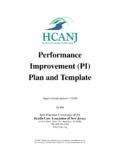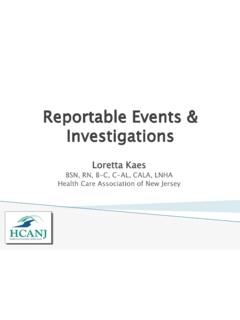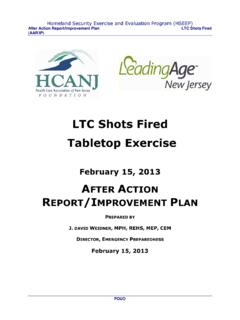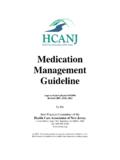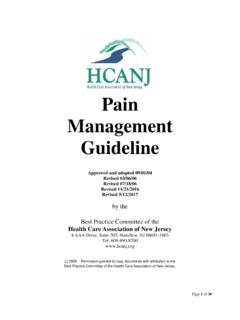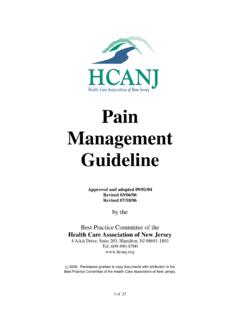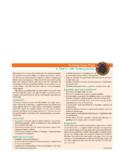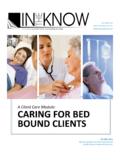Transcription of Fall Management Guideline - New Jersey (NJ) Nursing Home ...
1 1 fall Management Guideline Approved and adopted 09/2003 Revised 2006, 2007, 2010, 2011, 2012 by the Best Practice Committee of the Health Care Association of New Jersey 4 AAA Drive, Suite 203, Hamilton, NJ 08691-1803 Tel: 609-890-8700 2012. Permission granted to copy documents with attribution to the Best Practice Committee of the Health Care Association of New Jersey . 2 HCANJ Best Practice Committee s fall Management Guideline Table of Contents Page fall Management - 9 Best Practice Tools: Assessment, Plan of Care and Investigation - 16 fall Risk Predictive Factors Assessment Falls Management .
2 Optional Initial Plan of Care Falls Management Investigation Post fall Tool Falls Management Post fall Assessment Tool Tinetti Assessment - 20 Description Balance Gait Berg Balance - 26 Description Balance Scale Confidential Quality Improvement (QI) - 30 Facility Falls Summary Report Facility Falls Data Summary Falls Management guidelines Quantitative Measurement Record - 34 i 3 HCANJ Best Practice Committee s fall Management Best Practice Guideline Disclaimer: This Best Practice Guideline is presented as a model only by way of illustration.
3 It has not been reviewed by counsel. Before applying a particular form to a specific use by your organization, it should be reviewed by counsel knowledgeable concerning applicable federal and state health care laws and rules and regulations. This Best Practice Guideline should not be used or relied upon in any way without consultation with and supervision by qualified physicians and other healthcare professionals who have full knowledge of each particular resident s case history and medical condition. This Best Practice guidelines is offered to Nursing facilities, assisted living communities, residential health care facilities, adult day health services providers and other professionals for informational and educational purposes only.
4 The Health Care Association of New Jersey (HCANJ), its executers, administrators, successors, and members hereby disclaim any and all liability for damage of whatever kind resulting from the use, negligent or otherwise, of all Best Practice guidelines herein. This Best Practice Guideline was developed by the HCANJ Best Practice Committee ( Committee ), a group of volunteer professionals actively working in or on behalf of health care facilities in New Jersey , including skilled Nursing facilities, sub-acute care and assisted living providers.
5 The Committee s development process included a review of government regulations, literature review, expert opinions, and consensus. The Committee strives to develop guidelines that are consistent with these principles: Relative simplicity Ease of implementation Evidence-based criteria Inclusion of suggested, appropriate forms Application to various long term care settings Consistent with statutory and regulatory requirements Utilization of MDS (RAI) terminology, definitions and data collection Appropriate staff ( Management , Medical Director, Physicians, Nurse-Managers, Pharmacists, Pharmacy Consultants, Interdisciplinary Care Team)
6 At each facility/program should develop specific policies, procedures and protocols to best assure the efficient, implementation of the Best Practice Guideline s principles. The Best Practice guidelines usually assume that recovery/rehabilitation is the treatment or care plan goal. Sometimes, other goals may be appropriate. For example, for patients receiving palliative care, promotion of comfort (pain control) and dignity may take precedence over other Guideline objectives. guidelines may need modification to best address each facility, patient and family s expectations and preferences.
7 Recognizing the importance of implementation of appropriate guidelines , the Committee plans to offer education and training. The HCANJ Best Practice guidelines will be made available at 2012. Permission granted to copy documents with attribution to the Best Practice Committee of the Health Care Association of New Jersey . 4 HCANJ Best Practice Committee fall Management guidelines MISSION STATEMENT The Falls Management Program is designed to assist personnel to reduce falls, minimize injury and ultimately improve the quality of life of our residents.
8 This Best Practice Guideline should not be used or relied upon in any way without consultation with and supervision by qualified physicians and other healthcare professionals who have full knowledge of each particular resident s case history and medical condition. This Best Practice guidelines is offered to Nursing facilities, assisted living communities, residential health care facilities, adult day health services providers and other professionals for informational and educational purposes only. DEFINITION A fall is defined as an occurrence characterized by the failure to maintain an appropriate lying, sitting or standing position, resulting in an individual's abrupt, undesired relocation to the ground.
9 The definition of a fall extends to and includes following factors: An episode in which a resident has lost his/her balance and would have fallen were it not for staff intervention. The presence or absence of a resultant injury; a fall without injury is a fall . The distance to the next lower surface (in this case, the floor) does not determine the incidence of a fall . ( bed or mattress close to the floor) OBJECTIVES Limit and/or prevent the occurrence of falls within the parameters that can be controlled through structured program interventions.
10 Minimize the severity of injuries sustained by an elderly individual resulting from a fall . Provide the professional staff with standards of practice that will enable them to perform and teach effectively. Educate the resident, family and direct care and ancillary staff. Limit the liability and financial risk to the facility. PROGRAM OUTLINE Each health care system is encouraged to use this comprehensive Guideline to outline and further define its program specific, fall Management policy and procedures. I. KEY ELEMENTS TO A fall Management PROGRAM A.


